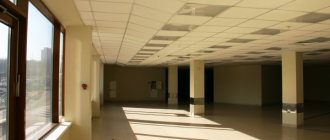How to transfer a house from non-residential to residential?
I am the owner of an unfinished house.
I want to assign it the status of residential premises in order to register and live in it. How to do it? Answer: Part 4 of Article 22 of the Housing Code of the Russian Federation establishes the conditions for the transfer of non-residential premises to residential premises.
First of all, this premises (house) must belong to the person who wants to carry out this manipulation, on the right of ownership without the claims of third parties.
Also, the house must fully comply with the requirements for residential premises or it must be possible to bring the house into compliance with them.
How to convert a room into an apartment
The procedure for transferring premises to an apartment is carried out in several stages. The building must comply with legal requirements, sanitary and fire safety standards.
Requirements
- A residential property cannot be located in a basement.
- It is unacceptable to place industrial or commercial equipment and equipment on the territory of residential buildings.
- Apartments located above garages are separated from them by the floor on which non-residential premises are located.
- Utility rooms, elevators, and garbage chutes must not be located adjacent to residential areas.
Before transferring a non-residential property to a housing one, those wishing to carry out the procedure must make sure that no penalties or judicial arrest have been imposed on the property, and that it is not under collateral. The house must meet the criteria for housing and have the necessary communications.
It is easier to transfer when the item was previously used as housing. Then the property was transferred to the non-residential category for the purpose of using it as an office, retail outlet, beauty salon, etc. In such a situation, you can draw up a plan yourself and carry out repair work after its approval.
Algorithm of actions on how to convert a non-residential building into a residential building
- Collection of necessary papers.
- Submitting a written application to executive authorities.
- Waiting for a response regarding permission or prohibition of the transfer. The request for transfer is considered for one and a half months.
- If the transfer is allowed, reconstruction and construction and repair work will be carried out in accordance with the submitted project.
- Upon completion of the reconstruction, call experts from the housing commission, who will draw up a certificate of completion of work and compliance of the property with the plan.
- Draw up a paper confirming ownership of the house in the Unified National Register of Real Estate.
- Make a technical passport at home.
In each specific case, the list of documents is slightly different.
What needs to be done to convert non-residential premises into residential ones
List of documents
- document identifying the applicant;
- proof of ownership of real estate;
- reconstruction plan for a house or apartment;
- conclusion of the housing commission regarding compliance with all requirements.
In addition to the main package, an additional list may be required:
- permission from other owners if the applicant owns part of the property;
- if one of the owners is a minor, the consent of the trustee service;
- protocol for a meeting of apartment owners for an apartment building, at which the majority spoke out that they did not object to the transfer procedure.
What you need and where to go
In order for your non-residential house to become residential, you will need the following documents:
- an application requesting the transfer of real estate from non-residential to residential;
- a copy of a passport or other identity document;
- title document for the house (sale and purchase agreement, certificate of inheritance, etc.);
- redevelopment and/or reconstruction project;
- conclusion of the SES and fire inspection that the house meets the requirements that the law imposes on residential premises.
If the property is located in an apartment building, you will need the consent of the residents of your entrance. It is drawn up in the minutes of the general meeting and certified by the signatures of all those present.
There are cases when the official owner of the premises is a minor child. Then you, as his legal representative, need a decision from the guardianship and trusteeship authorities certifying your authority.
Features of the sale of non-residential premises (apartment in a low-rise building)
Good afternoon It is planned to purchase non-residential premises (according to documents), in fact it is an apartment. The developer first planned shops, etc., and then gave it away for apartments, but in the documents the status of the premises is indicated as non-residential. What are the features of purchasing such an apartment and what risks might there be? It is clear that there is no possibility of registration, but this is not the most important thing. Thanks in advance for your answers!
Yulianna, good evening, you are purchasing ordinary apartments, and although the legal status of such premises has not yet been fixed at the legislative level, in general, this is the most ordinary real estate and the procedure for purchasing such an object is no different from purchasing a residential apartment. The main differences between apartments and residential apartments: 1. Non-residential premises (the legal status itself). 2. it is impossible to register, 3. an increased tax rate, which is calculated by the formula (area x cadastral value of sq.m.) x 0.5%, 4. unstable and often inflated prices for commodities. services, especially for heating 5. the ability to carry out almost any type of redevelopment, 6. lack of benefits and subsidies. As for the risks, for this it is necessary to check the premises for legal purity. I also advise you to go to the management company and find out all the information on tariffs for utility and TV/Internet services, which will help you better understand future costs.
Hello. I want to buy an apartment in an apartment building on the ground floor, which according to the documents is listed as non-residential premises. Previously belonged to the administration. What nuances may arise when purchasing? And what are the differences in its content (payments for housing and communal services, tariffs for services) in contrast to the ownership of residential premises?
We recommend reading: How much does a holder of the Order of Courage of the Month earn?
Olga, good evening! Payment depends on how the utilities are connected there and whether they are connected at all. In principle, you have the right to demand the conclusion of an agreement with the management company and not directly enter into one with each regional distribution network. Based on the tariffs for water and heat, it is possible that in your region there are lower tariffs for the population ( i.e. for residential premises), the cost of maintenance services (cleaning, etc.) in this regard should not differ from residential premises. Your electricity will definitely be more expensive, this issue is regulated at the federal level, taxation of non-residential premises is usually higher than residential
Documents for translation
The following institutions are involved in the transfer of real estate from non-residential to residential:
- Multifunctional Center;
- city property department;
- state portal of municipal services.
The documents indicated above are transferred to specialists of these organizations against receipt of receipt.
A decision on your application is made within 45 days from the date of your application. No later than three days after the decision is made, the applicant is given a certificate of transfer of the house from non-residential to residential. Owners of neighboring houses or apartments also receive notifications.
This act is considered the basis for assigning your home the status of a residential premises. To do this, you contact the cadastral authority of Rosreestr with an application to change the characteristics of the property. Based on your application, appropriate changes will be made to the State Real Estate Cadastre.
The following is provided to the cadastral body of Rosreestr:
- technical plan of the house;
- title documents.
Rosreestr employees request the act of transferring a house from non-residential to residential on their own.
67 lawyers on our permanent staff
295 consultations provided in the last month
Transferring residential premises to non-residential premises: step-by-step instructions, documents
Many novice businessmen are wondering how to make a store out of an apartment, step-by-step instructions for converting residential premises into non-residential premises. First, you need to prepare and submit to the municipality the following documents necessary for the transfer of residential premises to non-residential premises:
- application to change the status of the apartment;
- a copy of the property certificate certified by a notary office;
- two copies of the floor plan with a description of its technical characteristics;
- floor plan of the building in which the apartment is located;
- technical passport of the object;
- a plan for the reconstruction of the premises, if necessary for its further operation.
Important
To open a store in an apartment, it is mandatory to provide only a corresponding application and a redevelopment plan.
Free legal consultation We will answer your question in 5 minutes!
Ask a Question
The municipal authority will request the rest of the documentation independently from authorized organizations. However, it should be taken into account that in this case the translation time will increase significantly.
Free legal consultation
We will answer your question in 5 minutes!
Ask a Question
This is also important to know:
Resident parking permit in the city of Moscow in 2021
The package of documents can be submitted directly to the municipality or through the MFC (multifunctional center). In the second case, the processing time for the application increases by approximately 7 days.
People interested in how to turn an apartment into a store are concerned about how quickly they can find out a solution to their application. The decision is made within 1.5 months from the date of submission of documents. This decision is the basis for the initiation of actions aimed at reconstruction. No additional permits are required.
Important
The final document that will complete the transfer process will be the acceptance committee’s report drawn up upon completion of the reorganization.
When performing certain legally significant actions with real estate, it is necessary to obtain an extract from the house register.
Free legal consultation We will answer your question in 5 minutes!
Call: 8 800 511-39-66
Free legal consultation
We will answer your question in 5 minutes!
Ask a Question
The procedure for registering the transformation of real estate: how to convert residential premises into non-residential ones?
When transferring premises from residential to non-residential, a person may pursue different goals. Someone wants to open a store on the ground floor and sell products, while others want to create a full-fledged private office of a small enterprise in an apartment building.
In rural areas, the execution of such a transfer is usually associated with farming activities. The laws of the Russian Federation provide real opportunities for changing the purpose of the premises. If you act within the law and follow the established rules, the transfer procedure will be crowned with success.
Dear readers! Our articles talk about typical ways to resolve legal issues, but each case is unique.
How to convert a private residential building into non-residential premises
It is worth noting that housing redevelopment must be carried out not only actually, but also documented. It is necessary that it complies with sanitary, technical, fire safety, construction and environmental standards, otherwise no service will give permission.
Despite the fact that when transferring a private house to non-residential premises, permission from neighbors is not required, unlike a similar situation with an apartment, it should be taken into account that in some cases problems may arise later. Most often this happens when the owner decides to open a cafe or other entertainment establishment in close proximity to other buildings, and then residents begin to complain to the police, which can bring a lot of trouble to the business owner.
What premises can be made non-residential?
Only real estate that has the necessary conditions for this can be converted, transferred (withdrawn) from the residential category to non-residential. If there are no conditions, they need to be created.
An approximate order of conditions is as follows:
- the premises must have a separate entrance from the street (if there is no such entrance, it must be possible to create one);
- all owners must agree with the change in category;
- the property complies with the requirements and conditions of Chapter 3 of the Housing Code of the Russian Federation;
- ownership of the premises is not encumbered by pledge, lease, or other agreements.
So, when is translation not allowed?
The premises cannot be converted into non-residential:
- A room in which people are permanently registered. First, they must be discharged, and only then apply for transfer.
- Part of a communal apartment. Only the entire communal apartment can be transferred to non-residential, but part of it cannot be transferred under any circumstances.
- An apartment pledged or rented. For a successful transfer, it is necessary to terminate all contracts encumbering ownership rights.
- An apartment with living quarters located underneath. In this situation, transfer may be allowed, but this happens infrequently and depends on the characteristics of the exploitation of the future non-residential space.
This is important to know: Residential building and residential building: difference in 2021
The easiest way to carry out a transfer is if the premises are technically residential, but in fact unsuitable for habitation.
How to buy an apartment and turn it into a store
The usual minimum area of housing transferred to non-residential stock is a “studio” or one-room apartment. Moreover, the living space being redesigned cannot be located above residential premises, only above commercial ones. Considering the requirement for a separate entrance, apartments no higher than the second floor can be made non-residential, ideally premises on the ground or first floor.
The Privatization Commission takes into account numerous parameters, from the location and condition of an apartment building to assessing the benefits of commercial use. An important factor will be the intended purpose of the premises being converted into non-residential ones. As a rule, an apartment in non-residential status is more expensive.
The transfer of residential premises to non-residential premises is currently a frequent and understandable procedure. The transfer scheme is regulated by Chapter 3 of the Housing Code “Transfer of residential premises into non-residential premises and non-residential premises into residential premises”. Article 22 of the Housing Code specifies that when transferred to non-residential premises, the apartment must be located on the ground floor or above the non-residential premises. It is also important that the premises have a separate entrance and that no one lives in it or is registered. It is worth noting that after the transfer the entire premises must become completely non-residential, that is, one room cannot be left for permanent residence.
In your case, transferring to a non-residential fund is impossible, since the apartment is pledged by the bank (encumbrance in the form of a mortgage). To carry out the transfer procedure, you need to pay off the existing debt. The bank does not approve the transfer of housing to commercial real estate, which is due to concerns about the liquidity of the collateral.
- legality and justice;
- confidentiality;
- timeliness and reliability of obtaining the consent of the subject of personal data for the processing of personal data;
- processing only personal data that meets the purposes of their processing;
- compliance of the content and volume of processed personal data with the stated purposes of processing. The personal data processed should not be redundant in relation to the stated purposes of their processing;
- the inadmissibility of combining databases containing personal data, the processing of which is carried out for purposes incompatible with each other;
- storing personal data in a form that allows identifying the subject of personal data for no longer than required for the purposes of processing personal data;
- destruction or depersonalization of personal data to achieve the goals, their processing or in case of loss of the need to achieve these goals.
- by providing the subject with personal data when registering on the Site, when submitting applications, applications, questionnaires, forms, filling out registration forms on the Operator’s website or sending by e-mail, messages by telephone to the Operator’s support service;
- by other means that do not contradict the legislation of the Russian Federation and the requirements of international legislation on the protection of personal data.
Laws you should know
The main law that is subject to mandatory familiarization is Chapter 3 of the Housing Code of the Russian Federation. It is there, in articles 22 to 24, that contains comprehensive information on transferring premises in both directions. Moreover, the residential complex talks in more detail about the transfer of real estate from residential to non-residential.
It is necessary to familiarize yourself with other articles of the Housing Code of the Russian Federation:
- Article 5 states that local authorities have the right to establish special rules based on the specifics of the region, and therefore the features of translation in different regions of Russia may differ;
- Article 17 allows the use of an apartment in a high-rise building for business or professional activities (perhaps it should not be transferred to non-residential premises unless absolutely necessary?);
- Articles 36 and 40 speak of the need to obtain the consent of the owners of other premises in the house if redevelopment is required when transferring the premises to non-residential;
- Article 91 warns that premises in a rented house cannot be transferred to non-residential status under any circumstances.
How to arrange a transfer of premises?
Let's look at step-by-step translation instructions. The whole process is divided into 3 main stages.
Let's look at each of them separately:
- Collecting papers, obtaining permission to transfer.
The first stage is the entire “paper” part of the process. At this stage you will have to visit the Technical Inventory Bureau (BTI). They issue a technical certificate for the premises. To receive it, you need to write an application according to the sample.
It can be found directly at BTI. Having taken the technical passport and other papers, you need to go to the local government body, to its department dealing with real estate. There you need to write another application (in a more free form), submit documents and wait for a positive response. Calculating the cost of translation
At this stage you need to go to the BTI again. This time - not to the “window” for accepting applications, but to the privatization department of the housing stock management. Once again, an application is written, to which is attached the already issued permit and other documents. BTI appoints a commission that determines the difference in price between residential and non-residential premises. This difference, together with repair work, will make up the cost of the translation. Registration of ownership
This right can be registered at the Federal Registration Service or at the multifunctional center. When changing the category of premises, registration is required, although the applicant initially had ownership rights.
- applications to the BTI for obtaining a registration certificate for the premises
- applications to the BTI for obtaining a registration certificate for the premises
How to sell non-residential premises: a detailed guide to action
In the civil turnover of real estate, the purchase and sale of non-residential buildings and premises occupies a significant place. Offices, warehouses, industrial or retail sites, as commercial real estate, can act as a profitable investment project for investing free money.
- originals and copies of the organization's Charter, constituent agreement, extract from the Unified State Register of Legal Entities, certificates of registration of the enterprise and its registration with the Federal Tax Service;
- confirmation of the authority of the director of the enterprise;
- protocols confirming the approval of the transaction by the management body of the enterprise (founders or board of directors).
Question: If rooms in a communal apartment are privatized by their owners, do they need to privatize the common property? Answer: The procedure for owning common property in a communal apartment is defined in Art. 41-43 of the Housing Code of the Russian Federation: the owners of rooms in a communal apartment own, by right of common shared ownership, premises in this apartment used to service more than one room (hereinafter referred to as the common property in a communal apartment); the share in the right of common ownership of common property in a communal apartment of the owner of a room in a given apartment is proportional to the size of the total area of the specified room; the share in the right of common ownership of common property in a communal apartment of the owner of a room in a given apartment follows the fate of the right of ownership of the specified room; when transferring ownership of a room in a communal apartment, the share in the right of common ownership of the common property in this apartment of the new owner of such a room is equal to the share in the right of common ownership of the specified common property of the previous owner of such a room. Thus, the right to common property in a communal apartment arises from the owner of a room in this apartment by force of law.
Question: What list of documents is required to register a transaction for the sale and purchase of a room in a communal apartment from the seller/buyer? Answer: The procedure for state registration of rights to real estate and transactions with it is established by the Civil Code of the Russian Federation (hereinafter referred to as the Civil Code of the Russian Federation), Federal Law dated July 13, 2015 218-FZ “On State Registration of Real Estate” (hereinafter referred to as the Registration Law). In accordance with Art. 14, paragraph 3, art. 15, paragraph 8, art. 18 of the Federal Law of July 13, 2015 No. 218-FZ “On State Registration of Real Estate” (hereinafter referred to as the Registration Law), state registration of rights is carried out on the basis of an application from the parties to the agreement or persons authorized by them if they have notarized powers of attorney. If a transaction is made in notarial form, an entry in the state register can be made at the request of any party to the transaction, including through a notary (Article 8.1 Part 1 of the Civil Code of the Russian Federation). Acceptance of documents for state registration of rights is carried out at the State Budgetary Institution of the Kurgan Region “Multifunctional Center for the Provision of State and Municipal Services” (hereinafter referred to as the MFC). Offices in Kurgan: st. Kuibysheva, 144 building 41; st. K. Myagotina, 56a (House of Public Service); st. Nevezhina, 3 building 10 (RIO shopping center), 5th microdistrict, building No. 37 (tel. 44-35-36, 44-35-50). The purchase and sale agreement, concluded in simple written form, must be submitted in at least two original copies. A notarized agreement must be submitted in at least two copies, one of which (the original) is returned to the copyright holder (Clause 3, Article 21 of the Registration Law). In accordance with paragraph 6 of Art. 42 of the Housing Code of the Russian Federation (hereinafter referred to as the Housing Code of the Russian Federation), when selling a room in a communal apartment, the remaining owners of rooms in this communal apartment have a preemptive right to purchase the alienated room in the manner and under the conditions established by the Civil Code of the Russian Federation. The procedure and conditions for observing the pre-emptive right to purchase are established by Art. 250 of the Civil Code of the Russian Federation, according to which the seller of a share is obliged to notify in writing the other participants in shared ownership of his intention to sell his share to an outsider, indicating the price and other conditions under which he sells it. If the remaining participants in shared ownership refuse to purchase or do not acquire the sold share in the ownership of real estate within a month from the date of notification, the seller has the right to sell his share to any person. When selling a room in a communal apartment to an outsider, the application for state registration of rights must be accompanied by documents confirming the refusal of the owners of the remaining rooms in the communal apartment to purchase the room, or documents confirming the notification of the owners of the rooms about the sale. Failure to submit these documents is grounds for suspension of state registration of rights (clause 46, part 1, article 26 of the Registration Law). A state fee is charged for state registration of rights. The state fee for registering ownership of a room for an individual is 2,000 rubles (clause 22, clause 1, article 333.33 of the Tax Code of the Russian Federation). The payer of the fee is a person whose right is subject to state registration, i.e. buyer. We inform you that state registration of the transfer of rights to a real estate object is possible subject to the existence of state registration of previously arisen rights to this object in the Unified State Register of Real Estate (hereinafter referred to as the Unified State Register of Real Estate) (clause 3 of Article 69 of the Registration Law). In addition, the property in respect of which registration actions are required must be registered with the state cadastral register (Clause 4 of Article 1 of the Registration Law). It should be noted that by virtue of clause 3 of Art. 35 of the Family Code of the Russian Federation, in order for one of the spouses to enter into a transaction for the disposal of property, the rights to which are subject to state registration, a transaction for which the law establishes a mandatory notarial form, or a transaction subject to mandatory state registration, it is necessary to obtain the notarized consent of the other spouse.
We recommend reading: How much benefits does a single mother receive in Yaroslavl?
Filing an application
Physical entities
When submitting an application to transfer residential real estate to non-residential property, its owner must attach a number of documents:
application (there is no single form, only literacy, official language and a detailed statement of the reasons and purposes of the application are important);- passport of a citizen of the Russian Federation;
- papers on the ownership of this premises;
- technical passport of the premises;
- in the case of a multi-storey building - its floor plan;
- if redevelopment (reconstruction) is necessary, its detailed design.
Legal entities
The list of documents for legal entities is somewhat wider:
- all documents necessary for individuals;
- constituent documents of the organization;
- details of this organization (required – legal and actual address, telephone);
- power of attorney from the manager in the name of the employee who submits the application (it must be notarized).
As a rule, the transfer of residential premises to non-residential premises by legal entities is an individual process. For individuals, everything happens much more monotonously. Therefore, there is a high probability that the legal entity will be asked for some other documents. This may also be due to special rules in force in a particular region of Russia (Article 5 of the RF Housing Code).
How much to pay?
When converting real estate to non-residential, you need to pay a state fee. Its wording is “state duty for registration of non-residential premises.” The exact amount of payment is not established by law. It is calculated individually, based on the characteristics of the property, the conditions of its location, and the subtleties of the procedure.
This is important to know: How to calculate the usable area of an apartment
In addition to the state duty, you should be prepared for other expenses. At a minimum, this is payment for a registration certificate at the BTI and notary services, and at a maximum, payment for services for creating a redevelopment project and the repair work itself.
Where and how to submit documents?
The application and documents must be submitted to local authorities. Most often this is the city executive committee. Bodies can be either elected or appointed.
The main thing is that it should be local, municipal government.
Government agencies are not involved in processing the transfer of premises; they simply will not accept the application.
When submitting documents, you need to remember the following:
- The redevelopment project, if necessary, should already be ready. It must be submitted along with other documents. If the project has not yet been completed, then there is no point in writing a statement.
- The technical plan from the BTI does not need to be submitted. Local government employees will order this document themselves. But then, upon receipt of the results of the review, the person will be issued a receipt for payment of BTI services.
- The more detailed and competent the application is filled out, the better. Particular attention should be paid to the purposes of the transfer of premises and the legal grounds. The application should refer to the articles of the RF Housing Code.
How to convert commercial real estate into residential property?
The opposite situation is also possible if they want to turn an office into an apartment. The procedure is the same, but there are some subtleties
. The same list of documents and a similar application will be required. It is submitted to the local government body and considered in accordance with the general procedure.
The premises that need to be converted to residential status must meet the requirements
, listed in Decree of the Government of the Russian Federation dated January 28, 2006 N47:
- placement in a residential area;
- working condition of load-bearing structures;
- provision of utility networks (electricity, water supply and sewerage, heating and ventilation, in some cases gas supply);
- sanitary and epidemiological safety;
- if the room is located above the 5th floor, there must be an elevator.
And other requirements: there are many of them. But if the office was previously an apartment, then there should be no problems returning to its original state
. In this case, the minutes of the general meeting and the consent of adjacent owners of the premises are not required.
What decision can be made?
There are 2 solutions:
- permission to transfer premises from residential to non-residential;
- refusal to transfer.
In case of refusal, a person can either correct the deficiencies and re-apply, or go to court. The second option makes sense only if the person is sure that he was refused without reason. In some situations, refusal completely ends the matter. This happens if it is impossible to transfer the premises to non-residential (for example, it is located in a rented house).
And if the transfer is allowed, you can begin redevelopment and repair work. But it is necessary to act in accordance with the project, because after some time inspectors will come to the premises.
How can you register non-residential premises in a residential building?
In a residential building, you can transfer premises to non-residential property only if:
- it is located on the first floor of a multi-storey building;
- in a house with one apartment;
- located in an isolated building.
To register non-residential territory in a residential building, a list of papers is required. Transfer of a residential building, or part of it, into non-residential, what documents are needed:
- Technical document of the facility.
- Paper on state registration of ownership rights.
- Written permission for the transfer of all owners of the property.
The papers, along with the petition, are sent to the executive authorities. The application review period is two weeks. If a transfer is approved, registration of the change of assignment is required. Depending on the purpose of use, part of the house is subject to reconstruction and re-equipment. Only after all measures have been taken is a license issued to carry out trade or other business activities, if necessary.
When registering a part of a house that is residential as a non-residential property, it is prohibited to organize entertainment night establishments or industrial production with the release of harmful substances on its part.
When is redevelopment needed?
Redevelopment may be necessary if some changes need to be made to transfer to the non-residential category:
The most common condition is the presence of a separate entrance, isolated from the other residents of the house. If there is no such input, then you need to create it. This makes redevelopment inevitable, because the old entrance to the apartment is from the staircase and is not isolated. It is necessary to expand the window or make a new opening in the wall, creating a separate entrance from the street.- Another case is the peculiarities of the operation of the premises. When creating a transfer request, the property owner indicates the purpose (business, production, office, etc.). The premises must correspond to the stated purpose. Most often, this requires demolishing interior partitions.
When redeveloping, it is necessary to create a project. This must be done in advance, even before submitting an application for transfer. If the translation is approved, then all further actions must be carried out in strict accordance with the project. An inspection will likely come to the premises to determine whether the renovation work corresponds to what was stated in the project.
How long to wait for an answer?
The day the decision is made is not the deadline. The applicant will be notified of the results within 3 working days. Given the specifics of the postal service, the notification may not be delivered immediately. Therefore, after filing an application, a person should be patient.
Converting premises from residential to non-residential is not as difficult as it might seem. It’s easy to collect documents, but you will have to spend money on the technical plan and redevelopment project. Submitting an application along with documents is the final stage of the premises owner’s participation in the process. Then all that remains is to wait for the verdict of the local authorities.







